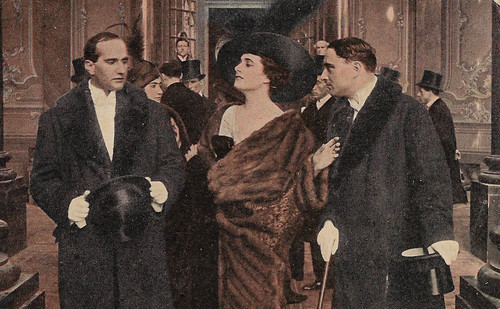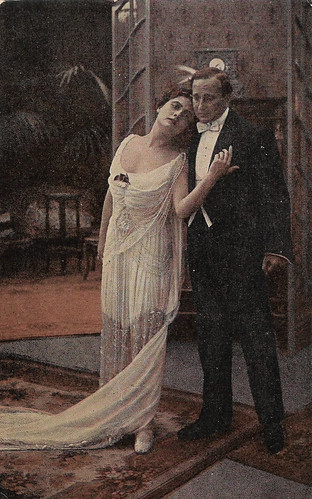
Spanish collector card by Chocolate Pi, Barcelona, no. 1 of series of 6 cards. Photo: Caesar Film. Francesca Bertini and Gustavo Serena in La signora delle camelie (Gustavo Serena, 1915). The man on the right is Carlo Benetti.

Spanish collector card by Chocolate Pi, Barcelona, no. 2 of series of 6 cards. Photo: Caesar Film. Francesca Bertini and Gustavo Serena in La signora delle camelie (Gustavo Serena, 1915).

Spanish collector card by Chocolate Pi, Barcelona, no. 3 of series of 6 cards. Photo: Caesar Film. Francesca Bertini and Gustavo Serena in La signora delle camelie (Gustavo Serena, 1915).
After a life with many men, she chooses Armand
La signora delle camelie/The Lady of the Camellias (Gustavo Serena, 1915) chronicles the well-known tragic love story of courtesan Marguerite Gautier (Francesca Bertini) and the provincial bourgeois Armand Duval (Gustavo Serena). After a life with many men, she chooses Armand. Yet, unknowing to Armand, Marguerite accepts Armand's father's (Antonio Cruichi) plea to separate herself from Armand because of the family's reputation and she sells all of her belongings.
Armand is so upset about the separation that, before a shocked audience of many, he throws stacks of money onto her, shouting out that he has now fully paid his debts. Marguerite withdraws and succumbs to tuberculosis. Armand, whose repenting father has confessed Marguerite's sacrifice, is just in time to hold her in his arms before she dies.
Alexandre Dumas's play was scripted by Renzo Chiosso, the cinematography was by Bertini's fixed cameraman Alberto Carta, and the sets were by Alfredo Manzi. In addition to Bertini, Serena, and Cruichi, also other Caesar Film regulars such as Olga and Carlo Benetti, and Camillo De Riso were part of the cast. Olga played the role of Marguerite's friend Mme Duvernoy, the Flora of Verdi's opera.
Dumas's play was indeed turned into one of the most famous operas by Giuseppe Verdi, 'La Traviata', in which the main characters were called Violetta and Alfredo. Even if a fiasco at its premiere in 1853 in Venice, it has become a classic, and probably Verdi's most performed opera. Arias from 'La Traviata' have led a life of their own, and the scene on the sixth card perfectly expresses the aria 'Addio al passato' in the opera.
Bertini's film was a huge hit at the time, and all over Europe, the film was shown for months in a row. And this despite fierce competition within Italy from a parallel released version of La signora delle camelie starring Hesperia, and directed by Hesperia's husband and promotor Baldassarre Negroni. While camera-wise perhaps not very innovative, the performances by the leads and the settings and costumes are very remarkable.
M. Congedi at IMDb: "In 1915, 'La Bertini' and Serena were setting standards in cinema worldwide with their subtle and realistic acting. This acting brilliance was most notable in their collaboration on the silent masterpiece Assunta Spina filmed in the same year, arguably the finest film made that year, anywhere. Compared to other major titles of the same period, this film lacks some of the technical brilliance that was developing in cinema at the time (e.g. camera movement, facial close-ups), but the film makes up for this lack in other ways. The compositions are elegant, the way scenes are lit are well thought out (note the light and darkness on Bertini's face in certain scenes), the acting subtle (for its time), the crowd scenes are so well-handled."
In 1992 a restoration of the film was made, on basis of, alas, poor materials. Provided with a new score by Ennio Morricone, the film was shown to the Roman beau-monde at the Teatro Sistina in Rome, a fitting venue for such a bourgeois spectacle. Unfortunately for Bertini, she had already died in 1985. She deplored in the documentary L'ultima diva (Gianfranco Mingozzi, 1983) that so little of her oeuvre had survived. Luckily, more and more film prints of her film career have shown up all over the globe and have been preserved, such as Sangue bleu and Il processo Clemenceau. Several titles are still missing, while from two other successful films of hers, Tosca and Fedora, only fragments have resurfaced but no complete prints.

Spanish collector card by Chocolate Pi, Barcelona, no. 4 of series of 6 cards. Photo: Caesar Film. Francesca Bertini and probably Antonio Cruichi in La signora delle camelie (Gustavo Serena, 1915). If this is the scene with Armand's father, then the Verdi operatic equivalent would be the aria of Germont: 'Di Provenza il mar, il suol'.

Spanish collector card by Chocolate Pi, Barcelona, no. 5 of series of 6 cards. Photo: Caesar Film. Francesca Bertini and Gustavo Serena in La signora delle camelie (Gustavo Serena, 1915). The little rotund man on the right is Camillo De Riso. The man just left of Serena, looking at him, is Carlo Benetti. The woman whose head is partly covered by Bertini is Olga Benetti.

Spanish collector card by Chocolate Pi, Barcelona, no. 6 of series of 6 cards. Photo: Caesar Film. Francesca Bertini in La signora delle camelie (Gustavo Serena, 1915).
Sources: Wikipedia and IMDb.
No comments:
Post a Comment